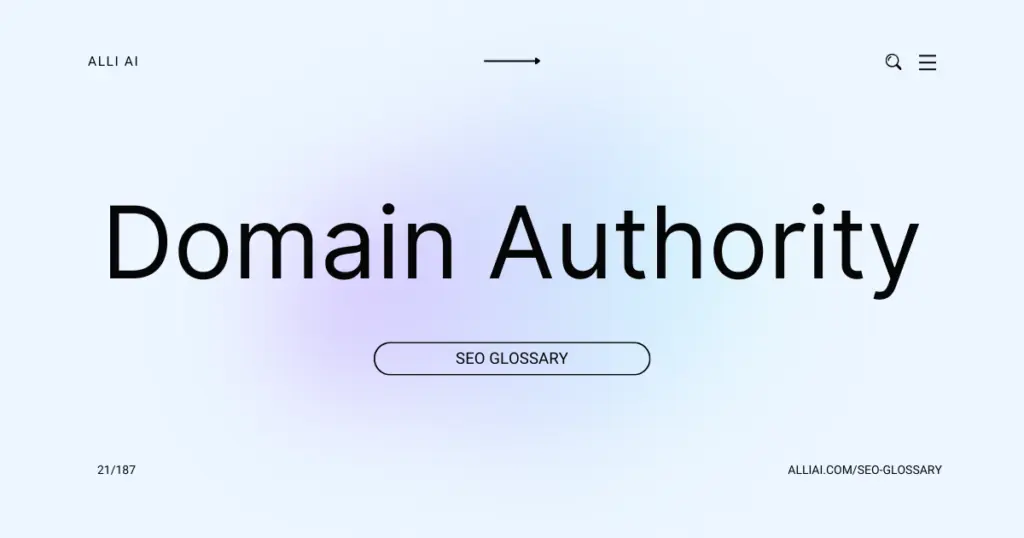What Does Domain Authority (DA) Mean?
Domain Authority (DA) is a score developed by Moz that predicts how likely a website is to rank in search engine results. This score ranges from 1 to 100, with higher scores indicating a greater ability to rank. DA is calculated by evaluating multiple factors, including linking root domains and the number of total links, into a single DA score. This score helps compare websites or track the “ranking strength” of a website over time.
Where Does Domain Authority (DA) Fit Into The Broader SEO Landscape?
Domain Authority (DA) is a metric developed by Moz that predicts how well a website will rank on search engine result pages (SERPs). It scores from 1 to 100, with higher scores indicating greater likelihood of ranking. DA is useful for comparing the strength of websites over time or against competitors, but it’s not a factor used by Google in determining search rankings.
In SEO, DA helps prioritize efforts by identifying potential websites for backlinking and benchmark performance against competitors. It provides a high-level view of how a domain’s cumulative SEO efforts stack up. As part of a broader SEO strategy, focusing on improving DA through quality content, strong internal linking, and earning high-quality backlinks can indirectly enhance visibility and organic search rankings, aligning with the pursuit of improving Google’s primary ranking factors such as relevance, authority, and trustworthiness. However, DA should be used as one of multiple metrics in SEO decision-making since it doesn’t directly impact Google rankings.
Real Life Analogies or Metaphors to Explain Domain Authority (DA)
1. Library and Books: Consider Domain Authority as the reputation of a library. Just like a popular library is known for having a comprehensive collection of books and resources, a website with a high Domain Authority is recognized as having a robust number of quality references (backlinks) and information (content). The more authoritative the books (backlinks from reputable sites), the higher the library’s (website’s) reputation.
2. Credit Score: Domain Authority is like a credit score for a website. Just as your credit score is a summary of your creditworthiness based on past financial behaviors and borrowings, Domain Authority sums up how trustworthy and authoritative a website is based on its historical backlink profile and its relationship to other sites in its industry.
3. Academic Reputation: Think of Domain Authority as the academic reputation of a scholar. A scholar with citations (backlinks) from other reputable academics (high-quality websites) is considered more authoritative in their field, similar to how a website’s DA increases with links from high-authority sites.
4. Mountain Climbing Gear: Domain Authority can be likened to the reliability of climbing gear when scaling a mountain. High-quality, well-known brand gear (strong, reputable backlinks) ensures a safer and more successful climb (search ranking), compared to unreliable or unknown gear (poor or spammy backlinks).
5. Restaurant Ratings: Imagine Domain Authority as restaurant ratings in a culinary guide. A high rating comes from consistently receiving good reviews from critics and patrons (quality backlinks) and indicates the restaurant is a trusted spot for good dining, much like a website is trusted for quality information when it has a high DA.
How the Domain Authority (DA) Functions or is Implemented?
1. Domain Authority Definition: Domain Authority is a metric developed by Moz. It predicts how likely a website is to rank in search engine result pages (SERPs).
2. Score Range: DA scores range from 1 to 100. The higher the score, the greater the potential for ranking.
3. Link Profile: DA is primarily calculated by evaluating a website’s link profile, which includes the number of total links and linking root domains.
4. Moz’s Link Explorer: The scoring uses Moz’s Link Explorer web index which maps the internet’s link structure.
5. Machine Learning Model: Moz uses a machine learning model that integrates many metrics (such as linking root domains, number of total links, spam score, and more) to closely mimic the workings of Google and predict ranking potential.
6. Comparison Metric: DA is best used as a comparative metric rather than an absolute one. It should be used to compare similar sites against one another, not to measure SEO success conclusively.
7. Periodic Updates: Moz updates DA scores periodically as the web evolves and as they refine their algorithms.
8. SEO Tool Integration: DA is incorporated into various SEO tools and platforms for SEO auditing, tracking, and strategic planning.
Impact Domain Authority (DA) has on SEO
Domain Authority (DA) impacts SEO performance primarily through influencing how high a website ranks in search engine results pages (SERPs). A higher DA suggests to search engines that a website is a credible, reliable source of information, which can lead to higher rankings. Websites with higher DA are often perceived as having more authoritative content, which can attract more backlinks naturally, further enhancing SEO performance.
Regarding user experience, while DA itself doesn’t directly affect it, high DA websites are typically those that offer quality content and good usability, factors that are integral to a positive user experience. Consequently, as these sites are more likely to rank higher in search results due to their authority, users are more likely to encounter reliable, high-quality sites early in their search efforts, indirectly improving their experience.
SEO Best Practices For Domain Authority (DA)
1. Audit Your Current Backlink Profile:
– Use tools like Moz’s Link Explorer, Ahrefs, or SEMrush to analyze your current backlinks.
– Identify and remove any toxic or spammy links.
2. Develop High-Quality Content:
– Create relevant, engaging, and original content that provides value to your audience.
– Ensure content is well-structured using H1, H2 tags, and includes multimedia elements like images and videos.
3. Internal Linking:
– Use internal links to help spread link equity throughout your website.
– Make sure the anchor text is relevant to the target page.
4. Gain High-Quality Backlinks:
– Reach out to relevant blogs, news sites, and industry influencers to earn high-quality backlinks.
– Consider guest blogging on reputable sites within your industry.
5. Optimize On-Page Elements:
– Ensure that titles, meta descriptions, and URLs contain relevant keywords and are optimally formatted.
– Use schema markup to help search engines understand your content better.
6. Use Social Media to Your Advantage:
– Share your content on social media sites to increase visibility and gain potential backlinks.
– Engage with followers to build relationships and encourage sharing.
7. Keep Your Website Mobile-Friendly:
– Make sure your website is responsive and loads quickly on all devices.
– Use Google’s Mobile-Friendly Test tool to check usability on mobile devices.
8. Regularly Update Your Content:
– Update old blog posts with new, relevant information and links.
– Refresh pages regularly to keep them relevant to search engine algorithms.
9. Increase User Engagement:
– Improve user experience (UX) to reduce bounce rates and increase time on site.
– Add calls-to-action (CTAs) and interactive elements to engage visitors.
10. Monitor Your Progress:
– Regularly check your Domain Authority using Moz’s Link Explorer to track improvements.
– Adjust strategies as necessary based on analytics data.
Implement these steps methodically and consistently to gradually improve your site’s Domain Authority.
Common Mistakes To Avoid
1. Misunderstanding DA’s purpose: Believing that DA is a direct ranking factor used by Google. To avoid this, focus on DA as a comparative tool rather than a definitive measure of SEO success.
2. Overemphasis on DA alone: Prioritizing DA improvement at the expense of other SEO aspects such as content quality, user experience, and technical SEO. Balance DA improvement efforts with comprehensive SEO strategies.
3. Neglecting page-level metrics: Ignoring Page Authority (PA) and other page-specific metrics for focusing solely on DA. Monitor and enhance both DA and PA for a balanced approach.
4. Chasing high DA links indiscriminately: Acquiring backlinks from high DA sites without considering relevance or the natural link profile. Aim for high-quality, relevant backlinks that contribute positively to your site’s authority and relevance.
5. Using black-hat techniques to inflate DA: Engaging in link schemes, private blog networks (PBNs), and other unethical practices to artificially boost DA. Stick to white-hat SEO strategies that comply with search engine guidelines.
6. Ignoring DA fluctuations: Misinterpreting normal fluctuations in DA as significant issues or successes. Recognize that DA can naturally fluctuate due to the changing index and link graph of the web.
7. Over-reliance on automated tools: Depending heavily on tools to calculate DA without understanding the underlying factors and methodology. Combine tool insights with manual audits and analysis for a well-rounded SEO approach.
8. Failure to track competitors’ DA: Focusing solely on improving your DA without considering competitors’ metrics. Regularly compare your DA with key competitors to identify areas for strategic improvement.
Avoid these pitfalls by maintaining a well-rounded perspective on DA, focusing on long-term SEO health, and adhering to ethical SEO practices.






